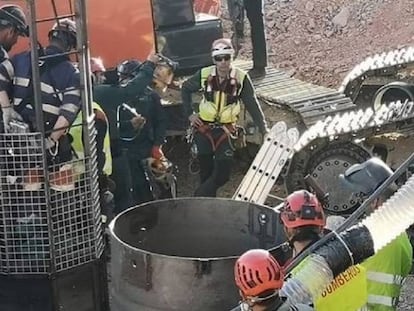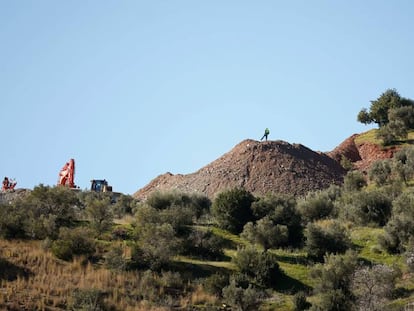Julen Roselló rescue: The 10 key factors of the mission
Eleven days after the two-year-old fell into a 110-meter-deep borehole, emergency teams are still working in hope of a miracle
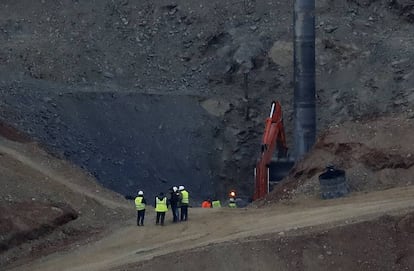
The mission to rescue Julen Roselló, a two-year-old thought to be trapped in a 110-meter borehole in southern Spain, has entered a critical phase. The toddler fell down the borehole on Sunday, January 13 in Totalán in Málaga, and since then rescuers have been working tirelessly to find him.
The operation has been hit with a series of setbacks due to the difficulty of the terrain and the dimensions of the borehole. As specialist miners prepare to begin the next stage of the operation, considered to be the most dangerous, EL PAÍS has put together the 10 key points of the rescue operation.
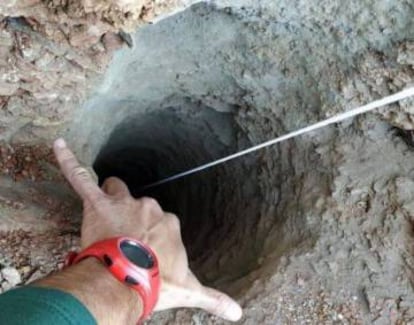
1. Dimensions of the borehole. The borehole is 110 meters deep but just 25 centimeters wide. The narrowness of the opening made it impossible for a rescuer to go down directly.
2. Evidence. From the start, the Civil Guard has focused its efforts on finding Julen. The toddler’s parents explained that the two-year-old had fallen down the borehole and samples taken on January 13 from within the hole tested positive for Julen’s DNA. Rescuers also found a bag of snacks and a cup the toddler was carrying when he fell.
3. Blockage. When a robotic camera was lowered into the borehole, it hit a blockage 71 meters below the surface. Rescuers tried to remove this blockage using various methods but only succeeded in taking out 31 centimeters of earth. This is when alternative rescue plans began to be considered.
4. Multiple alternatives. The first option rescuers considered was building a horizontal tunnel to the borehole. But the plan was ruled out following tests that showed the ground was too hard. The next idea was to drill two vertical tunnels parallel to the borehole. But to speed up the process, rescuers decided to excavate just one.
5. Difficult terrain. The land surrounding the borehole is made up of limestone, shale, phyllite and slate. This has made the mission extremely difficult, according to rescuers. The presence of quartzite and decomposing materials has made the ground unstable, an issue that could pose a safety risk to the rescuers. Given that no previous geological study has been made of the site, the team has come across these obstacles without warning.
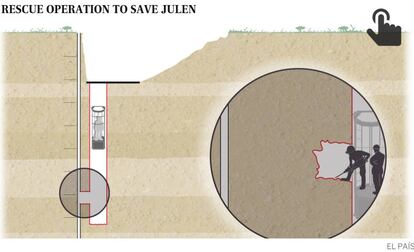
6. Expertise. The rescuers taking part in the operation are highly skilled. No one, for example, is more prepared than the members of the Hunosa Mining Rescue Brigade to complete the next stage of the mission: excavating a four-meter gallery, 60 meters below the surface. The rescue team also includes 13 engineers, led by Ángel García Vidal, as well as specialist firefighters from the Málaga Fire Department. The equipment on hand is the best available to complete the tasks and has been sent in from Málaga, Cádiz and Madrid. “There is nothing better on the market,” García Vidal confirmed a few days ago.
7. Large-scale operation. More than 300 people have been working in shifts since Sunday, January 13, to help rescue Julen. The team is made up of personnel from the Civil Guard, Civil Protection, Andalusian Emergency group (GREA), Eastern Andalusian Psychologist School, National Police, the Málaga Fire Department, Mining Rescue Brigade and experts from various private companies.

8. Support from Totalán. The rescue mission is being coordinated from a command center set up in the basement of Yolanda Alcaide, a local from Totalán who wanted to do her bit to help the operation. Another resident has given her home over to the parents of Julen, Victoria García and José Roselló. Many women from the small town have been making food for the rescuers. “I feel proud of all of them for their generosity, care and service to the family and all members of the rescue operation,” said Totalán Mayor Miguel Ángel Escaño. As well as help from Totalán, the rescuers have received food and goods from people across municipalities in Málaga and Andalusia.
9. Investigation. A Málaga courtroom has opened an investigation into the events surrounding the accident. Both the regional Andalusian government and Totalán Town Hall have confirmed that the borehole, drilled in search of water, had been made without the necessary permissions and licenses. The case will focus the investigation on the illegality of the borehole and land that was moved in the area. The Civil Guard is trying to determine which came first.
10. Media pressure. Every day, more journalists are arriving in Totalán to report on the news. The story is also receiving an increasing amount of coverage in the international media. There are crews on site from Portugal, the Netherlands, Germany and the United Kingdom. The rescuers are not used to this situation. In other situations, they leave media appearances to the politicians. The central government’s delegate in Andalusia, Alfonso Rodríquez Gómez de Celis, has asked the media to let the rescuers work “in peace and quiet” so they can “concentrate on the difficult job they have to do.” “The rescue team is working under immense pressure, to find a two-year-old child as quickly as possible. So I ask, especially the media, to not add more,” he said.
English version by Melissa Kitson.
Tu suscripción se está usando en otro dispositivo
¿Quieres añadir otro usuario a tu suscripción?
Si continúas leyendo en este dispositivo, no se podrá leer en el otro.
FlechaTu suscripción se está usando en otro dispositivo y solo puedes acceder a EL PAÍS desde un dispositivo a la vez.
Si quieres compartir tu cuenta, cambia tu suscripción a la modalidad Premium, así podrás añadir otro usuario. Cada uno accederá con su propia cuenta de email, lo que os permitirá personalizar vuestra experiencia en EL PAÍS.
¿Tienes una suscripción de empresa? Accede aquí para contratar más cuentas.
En el caso de no saber quién está usando tu cuenta, te recomendamos cambiar tu contraseña aquí.
Si decides continuar compartiendo tu cuenta, este mensaje se mostrará en tu dispositivo y en el de la otra persona que está usando tu cuenta de forma indefinida, afectando a tu experiencia de lectura. Puedes consultar aquí los términos y condiciones de la suscripción digital.
More information
Archived In
Últimas noticias
Most viewed
- Pablo Escobar’s hippos: A serious environmental problem, 40 years on
- Reinhard Genzel, Nobel laureate in physics: ‘One-minute videos will never give you the truth’
- Why we lost the habit of sleeping in two segments and how that changed our sense of time
- Charles Dubouloz, mountaineering star, retires at 36 with a farewell tour inspired by Walter Bonatti
- The Florida Keys tourist paradise is besieged by immigration agents: ‘We’ve never seen anything like this’

